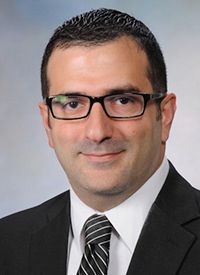Article
Manochakian Breaks Down Barriers to Genetic Testing in Lung Cancer
Author(s):
Rami Manochakian, MD, underscores the importance of looking for actionable alterations in lung cancer, barriers to genetic testing, and what is needed to overcome them.
Rami Manochakian, MD

All patients with advanced lung cancer should undergo genetic testing, both in the tissue and in the blood, to identify targetable mutations, according to Rami Manochakian, MD. Although this is understood to be best practice, several barriers still need to be overcome to ensure this testing is done, and that the results can then be used to inform the optimal approach for each patient.
“The standard of care is to check every patient with advanced non–small cell lung cancer and definitely [those with] adenocarcinoma [for mutations]. [We should] check from the tumor tissue and potentially from the blood,” said Manochakian. “We have some newer studies showing some good concordance—especially when you’re unable to check from the tissue. Check patients [for mutations] up front; their prognosis and survival will be different if they happen to carry a mutation.”
In an interview with OncLive® during a 2020 Institutional Perspectives in Cancer webinar on lung cancer, Manochakian, a thoracic medical oncologist at Mayo Clinic, underscored the importance of looking for actionable alterations in lung cancer, barriers to genetic testing, and what is needed to overcome them.
OncLive®: How have you seen a more widespread acceptance of molecular testing in lung cancer?
Manochakian: [It’s important to] check for mutations through the use of next-generation sequencing [NGS]. The oncology community, as a whole, has done a much better job of this [with the help of] national guidelines from societies such the American Society of Clinical Oncology [ASCO] and the European Society for Medical Oncology. We have a lot of recommendations [to turn to]. The bottom line is that these patients will benefit from targeted therapies, but only if you know that their tumors harbor those mutations.
In addition to EGFR, we have 6 or 7 other [mutations for which there are] FDA[-approved agents]. Many other options are potentially coming. It is actually much more beneficial for the patients if you do whole genome sequencing, or NGS, and it’s more cost-effective than checking for 1 mutation at a time.
How can the community overcome some of the barriers to genetic testing?
Knowledge, first and foremost, is key. One of the messages from ASCO this year was: Knowledge can cure cancer. I think spreading the knowledge and educating our providers everywhere [is important]. I believe that we are doing a good job with this. We also need to remember to discuss this with patients.
As far as barriers, if someone is doing NGS, [they are] sometimes [faced with] lack of tissue [which inhibits their ability] to send for [testing]. In the advanced setting, we now have more data [supporting that we should] test blood, which I am [in favor of]. We’re getting a lot of data showing concordance [for blood-based biopsies], so that might help [us address] one of the barriers of not having enough tissue or a specimen that is not good enough, which is something that we encounter.
It will be challenging for those with early-stage disease [now that] osimertinib [(Tagrisso) is] approved [in the adjuvant setting] because those patients may not actually have enough circulating [tumor] DNA in their blood. As such, you may not pick up a mutation. If you really wanted [to test] tissue, you would hope that if you have a really good surgical specimen, then you have enough tissue to run the test. However, we have seen that this could be challenging.
Another barrier is cost. I am hoping that with more support, guidelines, and FDA approvals, we’ll see more tests being [covered] by insurance companies. If not, many companies that are doing these tests have support programs. I just try to not take no for an answer. If my patient needs NGS, it’s for the best. We’re fighting with them and for them. We need to test, especially if someone has a higher chance of harboring a mutation, such as a nonsmoker. But some of these mutations are picked up even in smokers. For every patient with stage IV advanced lung cancer, and now potentially even in those with earlier stage disease, you’ve got to find a way to send for NGS.
Could you expand on the research examining concordance between tissue and liquid biopsy?
One very good study looked at NGS from the blood and tissue and created a lot of buzz. It shows the concordance, but it also shows that when you’re checking both, you’re actually picking up more mutations in certain patients because sometimes the tissue is not giving us [the answer].
Sometimes we presume that the tissue [test] is the most sensitive, but although the blood may have less sensitivity because it’s relying on circulating [tumor] DNA, the reality is if you do them both—which is something I personally advocate for—you have a higher chance of picking up mutations. It’s a topic that has continued to evolve. I am seeing more centers, more providers, and more oncologists checking for [these mutations]. We have some committees nationwide that are promoting checking for mutations in the blood. There is the issue of time; you get a faster turnaround time when you’re checking the blood. Sometimes you send for the tissue and you get the results of the blood even sooner.
[Some people ask], “Aren’t you better off from a cost effective standpoint of checking them sequentially?” If the tissue is not good enough, then check the blood, or vice versa, to save resources. I understand that notion and that point, but to me, we want to start treatment as soon as possible for patients. We don’t know whether that tissue is going to yield a positive result. Many of my colleagues and many national leaders in the field recommend sending NGS from both the blood and the tissue.




%20(2)%201-Recovered-Recovered-Recovered-Recovered-Recovered.jpg?fit=crop&auto=format)

%20(2)%201-Recovered-Recovered-Recovered-Recovered-Recovered.jpg?fit=crop&auto=format)
%20(2)%201-Recovered-Recovered-Recovered-Recovered-Recovered.jpg?fit=crop&auto=format)